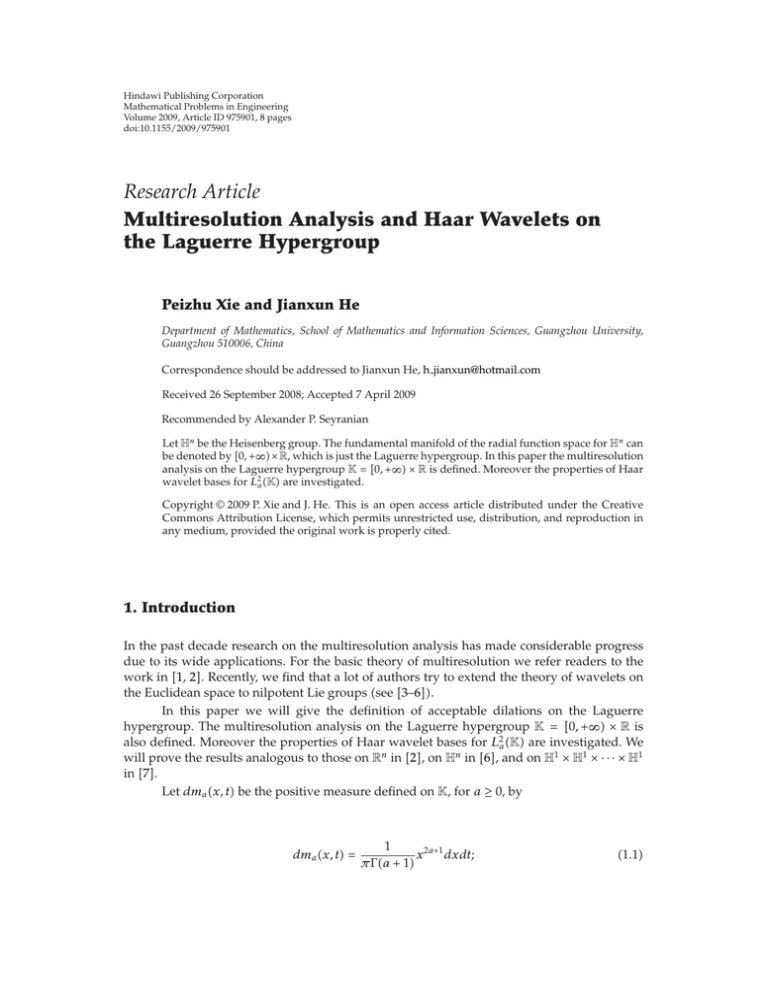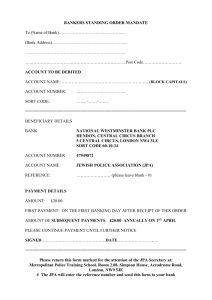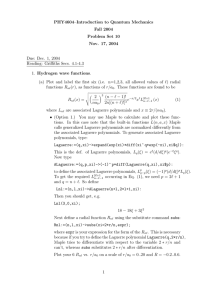Document 10951841
advertisement

Hindawi Publishing Corporation
Mathematical Problems in Engineering
Volume 2009, Article ID 975901, 8 pages
doi:10.1155/2009/975901
Research Article
Multiresolution Analysis and Haar Wavelets on
the Laguerre Hypergroup
Peizhu Xie and Jianxun He
Department of Mathematics, School of Mathematics and Information Sciences, Guangzhou University,
Guangzhou 510006, China
Correspondence should be addressed to Jianxun He, h jianxun@hotmail.com
Received 26 September 2008; Accepted 7 April 2009
Recommended by Alexander P. Seyranian
Let Hn be the Heisenberg group. The fundamental manifold of the radial function space for Hn can
be denoted by 0, ∞× R, which is just the Laguerre hypergroup. In this paper the multiresolution
analysis on the Laguerre hypergroup K 0, ∞ × R is defined. Moreover the properties of Haar
wavelet bases for L2a K are investigated.
Copyright q 2009 P. Xie and J. He. This is an open access article distributed under the Creative
Commons Attribution License, which permits unrestricted use, distribution, and reproduction in
any medium, provided the original work is properly cited.
1. Introduction
In the past decade research on the multiresolution analysis has made considerable progress
due to its wide applications. For the basic theory of multiresolution we refer readers to the
work in 1, 2. Recently, we find that a lot of authors try to extend the theory of wavelets on
the Euclidean space to nilpotent Lie groups see 3–6.
In this paper we will give the definition of acceptable dilations on the Laguerre
hypergroup. The multiresolution analysis on the Laguerre hypergroup K 0, ∞ × R is
also defined. Moreover the properties of Haar wavelet bases for L2a K are investigated. We
will prove the results analogous to those on Rn in 2, on Hn in 6, and on H1 × H1 × · · · × H1
in 7.
Let dma x, t be the positive measure defined on K, for a ≥ 0, by
dma x, t 1
x2a1 dxdt;
πΓa 1
1.1
2
Mathematical Problems in Engineering
and L2a K denotes the space of all measurable functions on K such that
2
f 2 La
K
|fx, t|2 dma x, t < ∞.
1.2
a
on K is defined by
The generalized translation operator Tx,t
a
f y, s
Tx,t
⎧ 2π 1/2
2
1
⎪
2
⎪
f
y
2xy
cos
θ
,
t
s
xysin
θ
dθ,
x
⎪
⎪
⎨ 2π 0
if a 0,
⎪
⎪
1/2
⎪
a 1 2π 2
a−1
⎪
⎩
f x y2 2xyρ cos θ
, t s xyρsin θ ρ1 − ρ2 dθdρ, if a > 0,
π 0 0
1.3
for all x, t ∈ K, f ∈ L2a K. It is said to be the Fourier transform of a function f ∈ L2a K
defined as follows:
m fλ,
K
ϕ−λ,m x, tfx, tdma x, t,
1.4
where ϕλ,m x, t eiλt Lam |λ|x2 , and the Laguerre function Lam is defined on R by Lam x e−x/2 Lam x/Lam 0, and Lam is the Laguerre polynomial of degree m and order a. We know
that for a pair of functions f and g, the generalized convolution product on the Laguerre
hypergroup is defined by
f ∗ gx, t K
a
Tx,t
f y, s g y, −s dma y, s ,
∀ x, t ∈ K.
1.5
Further if f and g are in L1 K, then we have
f
∗ g f · g .
1.6
The functional analysis and Fourier analysis on K and its dual have been extensively studied
in 8, 9.
Let Γ {m, n : m ∈ N, n ∈ Z} be a discrete subspace of K. An automorphism D is
said to be an acceptable dilation for Γ if it satisfies the following properties:
1 D leaves Γ invariant, that is, DΓ ⊆ Γ,
2 all the eigenvalues, λi , of D satisfy |λi | > 1.
The acceptable dilation D on L2a K is defined by Dfx, t fDx, y, for all f ∈
Let δr r > 0 be the dilation on the Laguerre hypergroup. Hence for all x, y ∈ K,
δr x, y rx, r 2 y. Clearly, for every r ∈ N and r ≥ 2, δr is just an acceptable dilation on the
Laguerre hypergroup. Now we give the definition of multiresolution analysis on the Laguerre
hypergroup.
L2a K.
Mathematical Problems in Engineering
3
Definition 1.1 MRAK, Γ, D. A multiresolution analysis on K is an increasing sequence
{Vj }j∈Z of closed subspaces of L2a K satisfying the following conditions:
1
j∈Z Vj
{0},
j∈Z Vj
L2a K;
2 f ∈ Vj ⇔ Df ∈ Vj1 ;
3 f ∈ V0 ⇔ Tγa f ∈ V0 , for all γ ∈ Γ;
4 there exists a scaling function φ ∈ V0 such that {Tγa φ}γ∈Γ forms an orthonormal basis
of V0 .
From the above definition it is clear that {DTγa φ}γ∈Γ is an orthonormal basis of V1 . It
follows from V0 ⊆ V1 and φ ∈ V0 ⊆ V1 that there exists a sequence {hγ}γ∈Γ such that
φ
h γ DTγa φ.
1.7
γ∈Γ
The solution of 1.7 is often called a refinable function or a scaling function and {hγ}γ∈Γ is
called a refinement sequence.
2. Acceptable Dilations on the Laguerre Hypergroup
In this section we will investigate the acceptable dilations on the Laguerre hypergroup. From
the previous argument, we know that the acceptable dilations on the Laguerre hypergroup
must satisfy three conditions:
1 they must be a automorphism of Laguerre hypergroup;
2 they must leave Γ invariant;
3 the modulus of their eigenvalues must be more than 1.
Theorem 2.1. The acceptable dilations on K must be the form
D
k1 0
k2 k 3
2.1
,
where k1 , k2 , k3 ∈ Z and k1 > 1, |k3 | > 1.
Proof. Let ac db be the acceptable dilations on K, where a, b, c, d ∈ R. From the condition 1,
we can obtain
x
D
ax by cx dy ∈ K,
y
∀x, t ∈ K,
2.2
which implies that ax by ≥ 0 for all x ≥ 0 and y ∈ R. This yields b 0 and a ≥ 0. From
DΓ ⊆ Γ, we get a, c, d ∈ Z. By using the condition 3 we can obtain that a > 1 and |d| > 1.
This concludes the proof of the theorem.
4
Mathematical Problems in Engineering
3. Multiresolution Analysis on the Laguerre Hypergroup
In this section, we only consider the dilation δr , where r ∈ N and r > 1. For simplicity we
denote it by δr α. In order to obtain the main theorem, we need to give some lemmas to
characterize the properties of the multiresolution analysis on K.
Lemma 3.1. SupposeVj ⊆ Vj1 j ∈ Z where Vj ⊂ L2a K and {Vj }j∈Z satisfies (2) and (4) of the
definition of multiresolution analysis on the Laguerre hypergroup. The characteristic function χQ of
the set Q is a scaling function of multiresolution analysis. Then j∈Z Vj {0}.
Proof. Let γ1 , γ2 ∈ Γ and γ1 /
γ2 . By using the property 4 of the Definition 1.1 we can obtain
Tγa1 χQ , Tγa2 χQ 0,
3.1
which implies that K Tγa1 χQ Tγa2 χQ dma 0. From 1.3, we know that Tγa χQ ≥ 0 and there exists
a constant C > 0 such that |Tγa χQ | ≤ C for all a ≥ 0 and γ ∈ K. This yields Tγa1 χQ Tγa2 χQ 0,
which implies that Tγa1 χQ and Tγa2 χQ cannot be nonzero at the same time.
Let f ∈ j∈Z Vj . Then f ∈ V−j for any j ∈ Z which implies that αj f ∈ V0 . Thus there
exists a sequence {bj γ}γ∈Γ such that αj f γ∈Γ bj γTγa χQ . This yields
j a α f bj γ Tγ χQ ≤ supbj γ Tγa χQ ≤ {bj γ}l2 Tγa χQ ,
γ∈Γ
γ∈Γ
r∈Γ
γ∈Γ
3.2
which implies that |αj f| ≤ C{bj γ}l2 . Then we can see that
fP αj α−j fP αj f α−j P ≤ C{bj γ} 2
l Γ
Cαj f 2 .
La
3.3
Notice that
j α f L2a
2
|α fP | dma
j
1/2
K
1/2
2
f αj P dma
3.4
K
∞ ∞
−∞
2
f r j x, r 2j y 0
2a1
x
dxdy
πΓa 1
1/2
r −a2j f L2a .
If we let j tend to infinity, then we can obtain f 0. This implies that
desired result is thus obtained.
j∈Z Vj
{0}. The
Lemma 3.2. Suppose Vj ⊆ Vj1 j ∈ Z, where Vj ⊂ L2a K and {Vj }j∈Z satisfies (2), (3), and (4) of
the definition of multiresolution analysis on the Laguerre hypergroup. If the scaling function φ in (4)
0, then j∈Z Vj L2a K.
is in L1a K and K φdma /
Mathematical Problems in Engineering
5
Proof. Let P x, t ∈ K and a > 0. Then we have
a
f y, s
TαP
a
Trx,r
2 t f y, s
a
π
2π 1 1/2
a−1
f r 2 x2 y2 2rxyr cos θ , s r 2 t rxyr sin θ r1 − r 2 dr dθ
0
0
1/2 2
y y a 2π 1
s
a−1
2 y
2
f r x 2 2x r cos θ
,r
t x r sin θ
r 1 − r 2 dr dθ
π 0 0
r
r
r
r2
y s
a
Tx,t
, 2
δr f
r r
a
α−1 Tx,t
αf,
3.5
a
which implies TαP
α−1 TPa α. For a 0, we can get the same result. It is easy to see that
a
−l a l
Tαl P α TP α , for all l ∈ Γ and a ≥ 0.
Let ϕ ∈ j∈Z Vj . Then there exists a j0 ∈ Z such that ϕ ∈ Vj0 . For any l ∈ Z, let j > −l
and j ≥ j0 . Using Vj ⊆ Vj1 , we immediately obtain ϕ ∈ Vj . Then there exists a sequence
{aj γ}γ∈Γ ∈ l2 Γ such that ϕ γ∈Γ aj γαj Tγa φ, which implies
Tαal P ϕ aj γ Tαal P αj Tγa φ aj γ αj Tαalj P Tγa φ.
γ∈Γ
3.6
γ∈Γ
Notice that P ∈ Γ, lj > 0, and lj ∈ Z. Thus we can see that αlj P ∈ Γ and αj Tαalj P Tγa φ ∈ Vj ,
which implies Tαal P ϕ ∈ Vj ⊆ j∈Z Vj , for all l ∈ Z and P ∈ Γ.
Let ψ ∈ j∈Z Vj . Then for any ε > 0, there exists a ϕ ∈ j∈Z Vj such that ϕ − ψL2a < ε.
It follows from Tαal P ϕ − Tαal P ψ 2 Tαal P ϕ − ψ 2 ≤ ϕ − ψL2a < ε and Tαal P ϕ ∈ j∈Z Vj
La
La
that Tαal P ψ ∈ j∈Z Vj , for all l ∈ Z and P ∈ Γ.
For any g ∈ K, there must exist an element P ∈ Γ and l ∈ Z such that |αl P − g| is
arbitrarily small, which implies that Tαal P ψ − Tga ψ < ε for any arbitrarily small ε > 0. This
2
yields Tga ψ ∈ j∈Z Vj , for all ψ ∈ j∈Z Vj and g ∈ K.
m ϕ−λ,m x, tφx, tdma and ϕλ,m x, t eiλt La |λ|x2 , φ ∈ L1 K. This
Note φλ,
m
a
K
m →
shows that φλ,
φdm
,
when
λ
→
0.
Since
φdm
0,
there
exists
some
ε > 0
/
a
a
K
K
⊥
such that φλ, m /
0 for all |λ| < ε. Let W j∈Z Vj and ψ ∈ W . Then ϕ, ψ 0 for all ϕ ∈ W,
which implies that for all g ∈ K,
0 Tga ϕ, ψ K
Tga ϕ x, y ψ x, y dma x, y K
Tga ϕ x, y ψ x, −y dma x, y ϕ ∗ ψ g ,
3.7
6
Mathematical Problems in Engineering
m 0. Notice that
where ψx,
y ψx, −y. Then ϕ
∗ ψλ,
m ϕλ,
mψλ,
αfλ,
m K
ϕ−λ,m x, tf rx, r 2 t dma
x t
,
f x , t dma ,
2
2a4
r r
r
K
2 x t
x
iλt/r 2 a
, 2 e
Lm |λ|
ϕλ,m
r r
r
1 2
eiλ/r t Lam 2 λx2
r
1
ϕ−λ,m
3.8
ϕλ/r 2 ,m x, t.
2
j fλ, m
, m, which implies α
Thus we can see that αfλ,
m 1/r 2a4 fλ/r
j2a4 2j
j2a4 j
2j
fλ/r , m. Let ϕ r
α φ. Then ϕ ∈ W and ϕ φλ/r , m. This yields
1/r
φ
λ
m 0.
, m ψλ,
r 2j
3.9
2j
m 0 when
Taking into account the fact that φλ/r
, m /
0 when |λ| < r 2j ε, we see ψλ,
2j
0 for all λ ∈ R which implies ψ 0. Then Vj |λ| < r ε. Let j tend to infinity, then ψ
j∈Z
L2a K. We complete the proof of this theorem.
Theorem 3.3. Suppose φ χQ is a scaling function for a multiresolution analysis associated with
Γ, α, where χQ is the characteristic function of a measurable set Q . Then Q satisfies the following
properties:
1 Tγa1 χQ Tγa2 χQ 0, for a.e. x ∈ K, γ1 / γ2 and γ1 , γ2 ∈ Γ;
a
2 χQ γ∈Γ βγαTγ χQ ;
3 |Q| 1;
4 Tγa1 Tγa2 χQ can be represented by the sequence {Tγa χQ }γ∈Γ where γ1 , γ2 ∈ Γ.
Conversely, the characteristic function of a bounded measurable set Q that satisfies properties (1), (2),
(3), and (4) is the scaling function of a multiresolution analysis associated with Γ, α.
Proof. Suppose φ χQ is a scaling function for a multiresolution analysis associated with
γ2 and γ1 , γ2 ∈ Γ, which implies
Γ, α. Then Tγa1 χQ , Tγa2 χQ 0 for all γ1 /
K
Tγa1 χQ Tγa2 χQ dma 0.
3.10
Notice that Tγa1 χQ ≥ 0 and Tγa2 χQ ≥ 0. Thus we can obtain that Tγa1 χQ Tγa2 χQ 0, almost every
x ∈ K. By 1.7, we know that the second property is satisfied. Because of χQ L2a 1, we
can see that |Q| 1. Let V0 ∈ MRAK, Γ, α. Then Tγa2 χQ ∈ V0 . This implies Tγa1 Tγa2 χQ ∈ V0 .
Therefore, Tγa1 Tγa2 χQ can be represented by {Tγa χQ }.
Mathematical Problems in Engineering
7
To see the converse, let
V0 ⎧
⎨
f∈
⎩
L2a K
⎫
⎬
a
c γ Tγ χQ ,
:f ⎭
γ∈Γ
Vj αj V0 .
3.11
Then {Vj }j∈Z is a family of closed subspace of L2a K. Let f ∈ V0 . Then
f
c γ Tγa χQ
γ∈Γ
c γ Tγa β γ1 αTγa1 χQ
γ∈Γ
γ1 ∈Γ
c γ β γ1 Tγa αTγa1 χQ
3.12
γ,γ1 ∈Γ
a
c γ β γ1 αTαγ
Tγa1 χQ .
γ,γ1 ∈Γ
a
Since αγ ∈ Γ, we can see that Tαγ
Tγa1 χQ ∈ V0 , which implies f ∈ V1 . This yields V0 ⊆ V1 .
Then we can also get Vj ⊆ Vj1 . Notice that f γ∈Γ cγTγa χQ . Thus we can see that Tγa1 f a a
a a
a
γ∈Γ cγTγ1 Tγ χQ , for all γ1 ∈ Γ. Because Tγ1 Tγ2 χQ can be represented by the sequence {Tγ χQ },
a
thus Tγ1 f ∈ V0 .
In order to show that {Vj }j∈Z is a multiresolution analysis associated with Γ, α, it
suffices to show that j∈Z Vj 0 and j∈Z Vj L2a K. Further, it follows easily from Lemmas
3.1 and 3.2 that
j∈Z
Vj 0,
Vj L2a K.
3.13
j∈Z
Our result is proved.
In this paper orthonormal Haar wavelet bases for L2a K are not constructed. But we
believe that orthonormal Haar wavelet bases for L2a K can be constructed just as that in
2, 6, 7. The details will appear elsewhere.
Acknowledgments
The second author is supported by the National Natural Science Foundation of China no.
10671041 and the Doctoral Program Foundation of the Ministry of Education of China
no. 200810780002. The authors would be grateful to the referee for his/her invaluable
suggestions.
8
Mathematical Problems in Engineering
References
1 I. Daubechies, Ten Lectures on Wavelets, vol. 61 of CBMS-NSF Regional Conference Series in Applied
Mathematics, SIAM, Philadelphia, Pa, USA, 1992.
2 K. Gröchenig and W. R. Madych, “Multiresolution analysis, Haar bases, and self-similar tilings of Rn ,”
IEEE Transactions on Information Theory, vol. 38, no. 2, part 2, pp. 556–568, 1992.
3 D. Geller, “Fourier analysis on the Heisenberg group. I. Schwartz space,” Journal of Functional Analysis,
vol. 36, no. 2, pp. 205–254, 1980.
4 W. Lawton, “Infinite convolution products and refinable distributions on Lie groups,” Transactions of
the American Mathematical Society, vol. 352, no. 6, pp. 2913–2936, 2000.
5 H. Liu and L. Peng, “Admissible wavelets associated with the Heisenberg group,” Pacific Journal of
Mathematics, vol. 180, no. 1, pp. 101–123, 1997.
6 H. P. Liu, Y. Liu, and H. H. Wang, “Multiresolution analysis, self-similar tilings and Haar wavelets on
the Heisenberg group,” to appear in Acta Mathematica Scientia Series B.
7 P. Z. Xie and J. X. He, “Multiresolution analysis and Haar wavelets on the product of Heisenberg
group,” International Journal of Wavelets, Multiresolution and Information Processing, vol. 7, no. 2, pp. 243–
254, 2009.
8 M. Assal and H. Ben Abdallah, “Generalized Besov type spaces on the Laguerre hypergroup,” Annales
Mathématiques Blaise Pascal, vol. 12, no. 1, pp. 117–145, 2005.
9 M. M. Nessibi and K. Trimèche, “Inversion of the Radon transform on the Laguerre hypergroup by
using generalized wavelets,” Journal of Mathematical Analysis and Applications, vol. 208, no. 2, pp. 337–
363, 1997.




